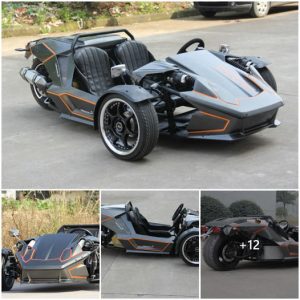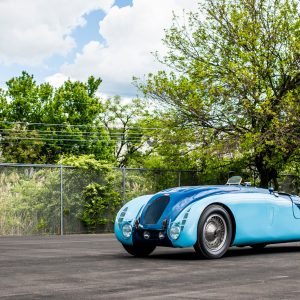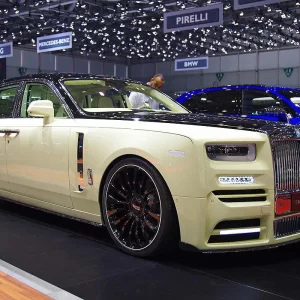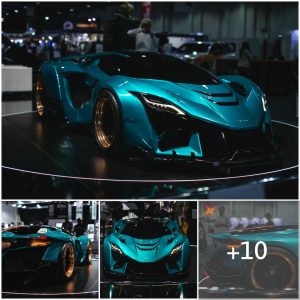Impressive range and a retro-future-digital design make for an impressive new sedan. But it isn’t a slam dunk.

It has almost become a given that a new Hyundai will be an excellent car. Not just one that is great to drive, but also one that is jam-packed with good design, thoughtful practicality, and true usability. So when I say the 2023 Hyundai Ioniq 6 did not surprise me in the slightest, I mean it in the best way possible. It is effortlessly good.
There’s something to be said for Hyundai making an EV sedan in a world that demands SUVs, though it has already covered those bases quite handily with the Ioniq 5, Genesis with the GV60, and Kia with the EV6. It released the volume sellers first. Now, this is Hyundai angling at market domination. There’s only one car that the Ioniq 6 is looking to erase: the Tesla Model 3.

The Basics
The most polarizing thing about the Ioniq 6 is how it looks. It’s a continuation of the idealized ‘80s digital future thesis that Hyundai has worked hard to cultivate in its new cars, and definitely the most interesting execution to my eyes. There’s a clear focus on exploring even more design possibilities without the limitations that come with a higher-riding SUV shape. It’s a stunning looking car in person, and the execution of every shape, detail, and line is top-notch. If there’s a pixel motif to be had, the Ioniq 6 finds a way to include it.
That’s not to say the Ioniq 6 is impractically designed, it just takes more liberties than the Ioniq 5. But that exterior allows it to have an impressively low 0.22 Cd, which contributes to its eye-popping 361-mile range on the longest-range variant. Most trims will land around 300 miles, even with all-wheel drive.
There are two available batteries feeding energy to three motor configurations: the standard range 53-kWh battery and the long-range 77.4-kWh battery that is shared with most other Hyundai and Kia EVs. The rear-wheel-drive standard range gets a 149-hp motor, while the RWD long range gets a 225-hp motor. At the top, the all-wheel-drive model only comes with the long-range battery and gets two motors making a total of 320 hp.


Visually, it pulls a similar trick to the Ioniq 5. It’s based on the same E-GMP platform as that car, meaning it’s actually a large sedan. The Ioniq 6 is 8.6 inches longer than the Ioniq 5, but has two inches less wheelbase. Meanwhile, it’s the same width as the 5, but the Ioniq 6 is 4.1 inches lower overall. Visually, it takes up very little room and always presents as a small car, which is a testament to the mastery of proportions from the Hyundai design team.
Inside, it gets even more design-y and cool. Largely owing to its engine-and-transmission-less EV packaging, the interior is palatial. Knee room felt endless, legroom in the front seat allowed for a full leg stretch while still allowing rear passengers to have ample room. The cabin feels more spacious than some full-size trucks I’ve been in. Vertically, however, things become surprisingly challenging. Even for my five-foot-nine frame, there wasn’t much extra space above my head in the front seat, and I was right at the limit in the rear seat. Hyundai says the inspiration for the rear seat is a couch, so tall people should get ready to slouch a bit and sink in. It’s the only real miss in the interior, but it is a fairly serious one.


I also had plenty of room to put my many things, with generously sized cupholders in the bridge-style center console and a huge space underneath that could fit a carry-on bag. A dedicated pocket for wireless charging keeps your phone safe, while the door pockets can hold a decent-sized water bottle, though not a wide one.
Beyond that, the interior was just cool looking. Hyundai went as close to maximum as possible, with easter eggs sprinkled across the cabin and huge focal points in the door panels. Those ridges in the door serve two purposes: to break up a large expanse of flat space and to provide reflective surfaces for the architectural ambient lighting that radiates upward. It’s the focal point of the interior and sells the hell out of it, and you can even choose any two colors you like and split them top to bottom.
Being cool looking takes the interior far, but the materials don’t hold up to scrutiny. Build quality is good, with no squeaks present, and most interior surfaces feel rigid and well-screwed together. But the surfaces themselves are mostly hard plastics, especially those eye-catching ridges on the door panels.
It does, however, benefit a lot from Hyundai’s typical laundry list of tech, which includes twin 12.3-inch displays and standard ADAS on all trims, with the SE getting Highway Driving Assist I (HDA) and the SEL and Limited getting HDA II, which adds machine learning to its algorithm. It does have Apple CarPlay, but the connection is wired.
Driving Experience
Setting off into the desert sunrise with an Ioniq 6 Limited AWD, it was fairly clear that my 150-mile round trip into the mountains and valleys of Arizona was going to be swathed in isolated comfort. This was an important and appreciated test of the true range of the Ioniq 6, and though the EPA-estimated range of my tester was 270 miles, the dash showed an optimistic 300 miles.
That radical exterior might inform certain conclusions about the Ioniq 6, but it took a second to recalibrate my brain to the car. I was expecting something sporty and spicy, something distinctly different from the Ioniq 5. But in truth, it was largely like the inspiration for the rear seats: a big ol’ road couch. It wasn’t blazingly fast like we expect modern EVs to be. Acceleration was downright modest, even with the 320-hp Limited I was assigned to. It was plenty, but not the shocking shove I’d come to expect.
Ride quality was great, not excellent. It was softly sprung but had slightly stiffer dampers to compensate for it, with the ride at low speed over busier surfaces not quite filtering out. Initially, I thought this indicated some level of sportiness, but in light twisties, the Ioniq 6 is dynamically on the dead side. It handles but not with pleasure, and it definitely doesn’t want to dance. At higher speeds, the ride quality sorts itself out and becomes excellent but strays farther away from sporty.
And the steering is tuned slightly differently to other Hyundai cars, with the Ioniq 6 having the characteristic big glut of weight on center that builds up with steering input but doesn’t transmit much road information to the hands. It’s tuned slightly lighter and definitely has much less road feel than other cars on E-GMP, but it is a pleasant handling car overall and fits the isolated character of the 6.
Quietness is something of a given for a new EV and there are no surprises with the Ioniq 6. Wind noise is all but eliminated from the driving experience, which isn’t too surprising considering the low drag coefficient. Road noise is extremely distant, and the cabin stays quiet deep into highway speeds. The two electric motors, while frankly not very potent in terms of acceleration, are quiet and have very little actual sound coming from them.
It is seriously comfortable and refined. While the front seats don’t initially inspire confidence for a long drive, they remain supportive and are adjustable enough to fit most body shapes. I won’t lie to you, it was a surprise to not feel sore after the drive because the seats don’t feel terribly comfortable initially. They’re meant for people who like a firm mattress.
Testing out the HDA II ADAS allowed me to really sink into the front seats and relax even more. It’s at the top of the market in terms of confidence and capability, with extremely good adaptive cruise and lane-keeping. Though it isn’t technically a hands-off system, the wide-open desert expanses with no traffic allowed me to experiment. It would keep a lane on a straight road almost indefinitely, requiring little to no actual input from my hands. Normally, this is terrifying but the system is good enough to keep it afloat.
Ultimately, isolation is the Ioniq 6’s greatest talent. Best of all, my indicated 300 miles of range settled down to 90 miles after the 150-mile drive. It sounds bad when you do the math, but keep in mind that I drove quite aggressively. It has good real-life range, all things considered.
Hyundai Ioniq 6 Options, Features, and Competition
There aren’t many option boxes to tick for the Ioniq 6, with most features stratified by trim level. The base SE is a cloth-interior champion that omits the ambient lighting and upgraded ADAS, but still comes with nearly everything you need. Most importantly the SE RWD long range starts at a competitive $46,615 and gets you 361 miles of range while still having most of the gadgetry and nice screens. You aren’t looking at the leather while driving, so the cabin feels largely the same.
The SEL is a little more expensive at $48,815 but includes the ambient lighting, larger range-killing 20-inch wheels, the upgraded HDA II, wireless phone charging, and an auto-dimming rearview mirror. The penalty? Range is down to 305 miles with the exact same drivetrain as the SE RWD long range.

The range-topping Limited starts at $53,715, the biggest price jump of all the trims. For your hard-earned, you get surround view parking assist, a sunroof, Bose audio, memory front seats, power-folding mirrors, a heated steering wheel, ventilated front seats, and the vehicle-to-load (V2L) system that lets you run a household blender in your Ioniq 6.
Of course, the Ioniq 6 is aiming directly at the Tesla Model 3, and Hyundai considers the Tesla its primary competition. The Ioniq 6 offers a lot more range for a few thousand more dollars but largely hangs out in the same neighborhood when it comes to pricing. But where the Ioniq 6 loses is horsepower and acceleration, with the $53,990 Model 3 Performance blowing the doors off of the Ioniq 6 Limited AWD while being cheaper. Speed clearly wasn’t Hyundai’s focus for the Ioniq 6’s first time at bat. Meanwhile, the Hyundai handily defeats the Polestar 2 in terms of range but also loses in performance.
The Ioniq 6 also isn’t cleanly eligible for the federal tax credit, meaning consumers will ultimately be spending more. This makes the range-topping Limited AWD feel very expensive at $57,215. The top of the range feels like a little bit of a reach, while the sweet spot is near (but not at) the bottom of the range. In my view, Hyundai’s latest EV is a winner in its 361-mile long range form, but a bit of a hard sell at the Limited AWD.
The Early Verdict
Ultimately, the 2023 Hyundai Ioniq 6 is Good. It’s very good. It could almost be a slam dunk, but it is missing out in two crucial areas: speed and headroom. I know it seems minor for shorter folks like me, but there are a lot of tall folks in the world. Having a new sedan that doesn’t comfortably accommodate people who are taller than six feet feels like a great way to pare your list of prospective buyers down, even if it’s for that sloping roofline. I personally could live without neck-breaking acceleration, but I suspect buyers will make comparisons to other, quicker EVs.
I walked away from the Ioniq 6 feeling a hint conflicted. It sold a lot to me visually, but the experience of driving it did not feel like the thesis I was presented with. It was a very normal, very comfortable, and very livable car. I desired for it to be more special and interesting to drive, especially considering that Ioniq 5 already did the normal and good thing quite well and that the Genesis GV60 felt so unique on the same platform.
But truthfully, the Ioniq 6 is an exceptional offering. You just need to pick your trim levels right, and by right I mean get the long-range RWD and don’t look back.





